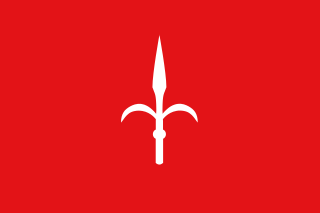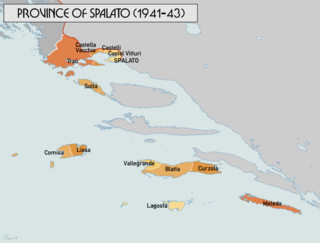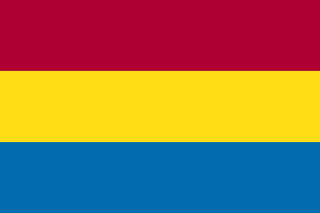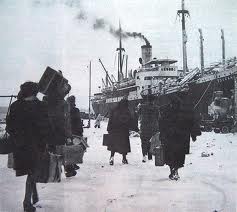
The Free Territory of Trieste was an independent territory in Southern Europe between northern Italy and Yugoslavia, facing the north part of the Adriatic Sea, under direct responsibility of the United Nations Security Council in the aftermath of World War II. For a period of seven years, it acted as a free city.

Rijeka, also known as Fiume, is the principal seaport and the third-largest city in Croatia. It is located in Primorje-Gorski Kotar County on Kvarner Bay, an inlet of the Adriatic Sea and in 2021 had a population of 108,622 inhabitants. Historically, because of its strategic position and its excellent deep-water port, the city was fiercely contested, especially between the Holy Roman Empire, Italy and Croatia, changing rulers and demographics many times over centuries. According to the 2011 census data, the majority of its citizens are Croats, along with small numbers of Serbs, Bosniaks and Italians.
The Treaty of Rome was agreed on 27 January 1924, when Italy and the Kingdom of Serbs, Croats and Slovenes agreed that Fiume would be annexed to Italy as the Province of Fiume, and the town of Sušak would be part of the Kingdom of Serbs, Croats and Slovenes.

The provinces of Italy are the second-level administrative divisions of the Italian Republic, on an intermediate level between a municipality and a region. Since 2015, provinces have been classified as "institutional bodies of second level".

Pula, also known as Pola, is the largest city in Istria County, Croatia, and the seventh-largest city in the country, situated at the southern tip of the Istrian peninsula in northwestern Croatia, with a population of 52,220 in 2021. It is known for its multitude of ancient Roman buildings, the most famous of which is the Pula Arena, one of the best preserved Roman amphitheaters. The city has a long tradition of wine making, fishing, shipbuilding, and tourism. It was the administrative centre of Istria from ancient Roman times until superseded by Pazin in 1991.

Province of Spalato was a province of the Italian Governorate of Dalmatia, created in May 1941 during World War II. It lasted until September 1943.

Italian irredentism was a political movement during the late 19th and early 20th centuries in Italy with irredentist goals which promoted the unification of geographic areas in which indigenous peoples were considered to be ethnic Italians. At the beginning, the movement promoted the annexation to Italy of territories where Italians formed the absolute majority of the population, but retained by the Austrian Empire after the Third Italian War of Independence in 1866. During World War I the main "irredent lands" were considered to be the provinces of Trento and Trieste and, in a narrow sense, irredentists referred to the Italian patriots living in these two areas.

The Julian March, also called Julian Venetia, is an area of southeastern Europe which is currently divided among Croatia, Italy, and Slovenia. The term was coined in 1863 by the Italian linguist Graziadio Isaia Ascoli, a native of the area, to demonstrate that the Austrian Littoral, Veneto, Friuli, and Trentino shared a common Italian linguistic identity. Ascoli emphasized the Augustan partition of Roman Italy at the beginning of the Empire, when Venetia et Histria was Regio X.

The Austrian Littoral was a crown land (Kronland) of the Austrian Empire, established in 1849. It consisted of three regions: the Margraviate of Istria in the south, Gorizia and Gradisca in the north, and the Imperial Free City of Trieste in the middle. The region has been contested frequently, with parts of it controlled at various times by the Republic of Venice, Austria-Hungary, Italy, and Yugoslavia among others.

The Free State of Fiume was an independent free state that existed between 1920 and 1924. Its territory of 28 km2 (11 sq mi) comprised the city of Fiume and rural areas to its north, with a corridor to its west connecting it to the Kingdom of Italy.

The Istrian–Dalmatian exodus was the post-World War II exodus and departure of local ethnic Italians as well as ethnic Slovenes and Croats from Yugoslavia. The emigrants, who had lived in the now Yugoslav territories of the Julian March, Kvarner and Dalmatia, largely went to Italy, but some joined the Italian diaspora in the Americas, Australia and South Africa. These regions were ethnically mixed, with long-established historic Croatian, Italian, and Slovene communities. After World War I, the Kingdom of Italy annexed Istria, Kvarner, the Julian March and parts of Dalmatia including the city of Zadar. At the end of World War II, under the Allies' Treaty of Peace with Italy, the former Italian territories in Istria, Kvarner, the Julian March and Dalmatia were assigned to the nation of Yugoslavia, except for the Province of Trieste. The former territories absorbed into Yugoslavia are part of present-day Croatia and Slovenia.

The Operational Zone of the Adriatic Littoral was a Nazi German district on the northern Adriatic coast created during World War II in 1943. It was formed out of territories that were previously under Fascist Italian control until its takeover by Germany. It included parts of present-day Italian, Slovenian, and Croatian territories. The area was administered as territory attached, but not incorporated, to the Reichsgau of Carinthia. The capital of the zone was the city of Trieste.

The Italian language is an official minority language in Croatia, with many schools and public announcements published in both languages. Croatia's proximity and cultural connections to Italy have led to a relatively large presence of Italians in Croatia. Italians were recognized as a state minority in the Croatian Constitution in two sections: Istrian Italians and Dalmatian Italians. Although only 0.43% of the total population is Italian by citizenship, many more are ethnically Italian and a large percentage of Croatians speak Italian, in addition to Croatian.

The foibe massacres, or simply the foibe, refers to mass killings and deportations both during and immediately after World War II, mainly committed by Yugoslav Partisans and OZNA in the then-Italian territories of Julian March, Kvarner and Dalmatia, against local Italians and Slavs, primarily members of fascist and collaborationist forces, and civilians opposed to the new Yugoslav authorities. The term refers to some victims who were thrown alive into the foibe., deep natural sinkholes characteristic of the Karst Region. In a wider or symbolic sense, some authors used the term to apply to all disappearances or killings of Italian and Slavic people in the territories occupied by Yugoslav forces. Others included deaths resulting from the forced deportation of Italians, or those who died while trying to flee from these contested lands.
Rijeka, formerly known as Fiume, is a city located in the northern tip of the Kvarner Gulf in the northern Adriatic. It is currently the third-largest city in Croatia. It was part of the Roman province of Dalmatia, and later of the Kingdom of Croatia. It grew during the 12th to 14th centuries as a seaport within the Holy Roman Empire, trading with Italian cities. Under the rule of the House of Habsburg from 1466, it was made a free city; and, although part of the Duchy of Carniola, it developed local self-government.

Istrian Italians are an ethnic group from the Adriatic region of Istria in modern northwestern Croatia and southwestern Slovenia. Istrian Italians descend from the original Latinized population of Roman Histria, from the Venetian-speaking settlers who colonized the region during the time of the Republic of Venice, and from the local Croatian people who culturally assimilated.

Italians of Croatia are an autochthonous historical national minority recognized by the Constitution of Croatia. As such, they elect a special representative to the Croatian Parliament. There is the Italian Union of Croatia and Slovenia, which is a Croatian-Slovenian joint organization with its main site in Rijeka, Croatia and its secondary site in Koper, Slovenia.
Mutilated victory is a term coined by Gabriele D’Annunzio at the end of World War I, used to describe the dissatisfaction of a part of Italian nationalists concerning territorial rewards in favor of the Kingdom of Italy after the conflict.

The province of Fiume was a province of the Kingdom of Italy from 1924 to 1943, then under control of the Italian Social Republic and German Wehrmacht from 1943 to 1945. Its capital was the city of Fiume. It took the other name after the Gulf of Carnaro.

The Italian irredentism in Istria was the political movement supporting the unification to Italy, during the 19th and 20th centuries, of the peninsula of Istria. It is considered closely related to the Italian irredentism in Trieste and Rijeka (Fiume), two cities bordering the peninsula.


















